
Kolkata is the capital and largest city of the Indian state of West Bengal. It lies on the eastern bank of the Hooghly River, 80 km (50 mi) west of the border with Bangladesh. It is the primary financial and commercial centre of eastern and northeastern India. Kolkata is the seventh most populous city of India with an estimated city proper population of 4.5 million (0.45 crore). It is the centre of the Kolkata Metropolitan Region, one of the most populous metropolitan areas in the world with a population of over 15 million residents. Kolkata is the de facto cultural capital of India and a historically and culturally significant city in the historic region of Bengal. It is the second largest Bengali-speaking city in the world. It has the highest number of Nobel laureates among all cities in India.

The Battle of Plassey was a decisive victory of the British East India Company, under the leadership of Robert Clive, over the Nawab of Bengal and his French allies on 23 June 1757. Robert Clive was paid £1 million by the Jagat Seth family - a rich Indian family business group - to defeat Siraj-ud-Daulah. The victory was made possible by the defection of Mir Jafar, Nawab Siraj-ud-Daulah's commander in chief who was also paid by the Jagat Seths. The battle helped the British East India Company take control of Bengal in 1772. Over the next hundred years, they continued to expand their control over vast territories in the rest of the Indian subcontinent, including Burma.

Mirza Muhammad Siraj-ud-Daulah, commonly known as Siraj-ud-Daulah or Siraj ud-Daula, was the last independent Nawab of Bengal. The end of his reign marked the start of the rule of the East India Company over Bengal and later almost all of the Indian subcontinent.

Balaji Baji Rao, often referred to as Nana Saheb I, was the 8th Peshwa of the Maratha Confederacy. He was appointed as Peshwa in 1740 upon the death of his father, the Peshwa Bajirao I.

The Nawab of Bengal was the hereditary ruler of Bengal Subah in Mughal India. In the early 18th-century, the Nawab of Bengal was the de facto independent ruler of the three regions of Bengal, Bihar and Orissa which constitute the modern-day sovereign country of Bangladesh and the Indian states of West Bengal, Bihar and Odisha. The Bengal Subah reached it's peak during the reign of Nawab Shuja-ud-Din Muhammad Khan. They are often referred to as the Nawab of Bengal, Bihar and Orissa. The Nawabs were based in Murshidabad which was centrally located within Bengal, Bihar, and Odisha. Their chief, a former prime minister, became the first Nawab. The Nawabs continued to issue coins in the name of the Mughal Emperor, but for all practical purposes, the Nawabs governed as independent monarchs. Bengal continued to contribute the largest share of funds to the imperial treasury in Delhi. The Nawabs, backed by bankers such as the Jagat Seth, became the financial backbone of the Mughal court.

Mir Syed Jafar Ali Khan Bahadur was a commander-in-chief or military general who reigned as the first dependent Nawab of Bengal of the British East India Company. His reign has been considered by many historians as the start of the expansion of British control of the Indian subcontinent in Indian history and a key step in the eventual British domination of vast areas of pre-partition India.
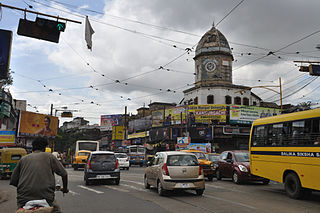
Maniktala is a residential area of North Kolkata, in Kolkata district, West Bengal, India.

Kalikata was one of the three villages which were merged to form the city of Kolkata in India. The other two villages were Gobindapur and Sutanuti. Job Charnock, an administrator with the British East India Company is traditionally credited with the honour of founding the city. He settled in the village of Sutanuti.

Alivardi Khan was the Nawab of Bengal from 1740 to 1756. He toppled the Nasiri dynasty of Nawabs by defeating Sarfaraz Khan in 1740 and assumed power himself.
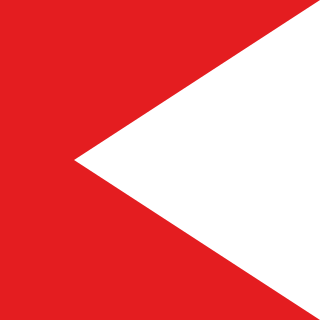
The Kingdom of Nagpur was an Indian kingdom within the Maratha Confederacy in the 18th and 19th centuries. It came under the rule of the Marathas of the Bhonsle dynasty in the mid-18th century. The city of Nagpur was the capital of the state.

Chitpur is a neighbourhood in North Kolkata in Kolkata district in the Indian state of West Bengal. Sometimes, the entire area along Chitpur Road is referred to as Chitpur, although the various localities have distinctive names.
Bargis were a light cavalry mercenary group of Maratha Empire's who indulged in large scale plundering of the countryside of western part of Bengal for about ten years (1741–1751) during the Maratha invasions of Bengal. Maratha invasions took place almost as an annual event for 10 years.
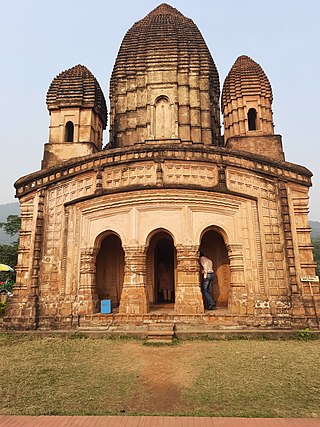
Garh Panchkot is a ruined fort located in the eastern part of India at the foothills of Panchet Hill in the district of Purulia, West Bengal. The ruins of the Panchkot Palace are a silent testimony to the Bargi attack during the 18th century.
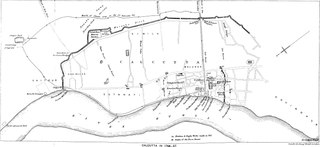
The Maratha invasions of Bengal (1742–1751), also known as the Maratha expeditions in Bengal, were the frequent invasions by the Maratha forces in the Bengal Subah, after their successful campaign in the Carnatic region at the Battle of Trichinopoly. The leader of the expeditions was Raghoji Bhonsle of Nagpur. The Marathas invaded Bengal five times from April 1742 to March 1751, which caused widespread economic losses in the Bengal Subah.

The Bengal Subah, also referred to as Mughal Bengal, was the largest subdivision of the Mughal Empire encompassing much of the Bengal region, which includes modern-day Bangladesh, the Indian state of West Bengal, and some parts of the present-day Indian states of Bihar, Jharkhand and Odisha between the 16th and 18th centuries. The state was established following the dissolution of the Bengal Sultanate, a major trading nation in the world, when the region was absorbed into the Mughal Empire. Bengal was the wealthiest region in the Indian subcontinent.
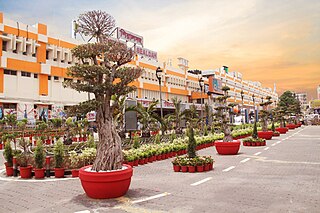
Sealdah is a neighbourhood of Central Kolkata in Kolkata district in the Indian state of West Bengal.
Dihi Panchannagram was a group of 55 villages which the East India Company purchased in 1758 from Mir Jafar, after the fall of Siraj-ud-daulah, the last independent Nawab of Bengal, in what is now the city of Kolkata, earlier known as Calcutta, in Kolkata district, in the Indian state of West Bengal. These villages initially developed as suburbs of Kolkata, but now forms part of the city proper within the limits of the Kolkata Municipal Corporation.
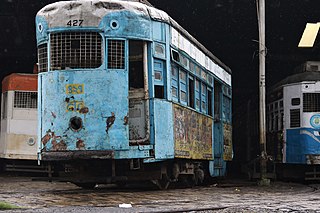
Beniapukur is a neighbourhood of Central Kolkata in Kolkata district in the Indian state of West Bengal. It is adjacent to Park Circus.

Jagat Seth was a wealthy merchant, banker and money lender family from Murshidabad in Bengal during the time of the Nawabs of Bengal.
Bhaskar Ram Kolhatkar, known as Baba Bhaskar Pandit by the people of Bengal, was a Maratha general and statesman. He was the dewan of the raja of Nagpur, Raghuji Bhonsle. He played an important role in the kingdom of Nagpur's expansion. The first Maratha invasion of Bengal in 1741, as also the third in 1744, was led by him. He was an able military leader, proven by his success in the Maratha invasions of Bengal and conquest of Chhattisgarh. He was killed by Alivardi Khan on 30 March 1744.

















